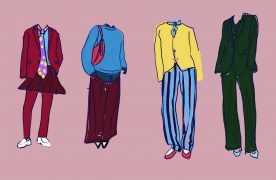Fast fashion has been such a common phrase that circulates the discussion around what individual actions can be taken to be more sustainable. Key aspects of this phenomenon include fashion and manufacturing methods that focus on producing high volumes of clothing, very rapidly. These companies tend to replicate trending items from other designers and use low-quality — usually synthetic — fabrics. Brands known for fast-fashion practices include Zara, Primark, H&M, Forever 21 and Fashion Nova.
Fast fashion brands usually benefit from the inconvenience of shopping secondhand. If someone is looking for a specific shirt, in a specific color and style, they may not be able to find it in a thrift shop. Then, fast fashion becomes the convenient way out — with one-day, free shipping and discounts from spending $100 and more, consumers are enticed to find that one piece they were looking for, all at the click of a button.
Convenience is not the only element that makes fast fashion so alluring. These companies are also capable of producing clothing that’s on trend faster than regular manufacturers.

The trend cycles that have dominated popular culture — and therefore, the fashion industry — often lead people to continuously buy more in order to keep up with what is “on trend” any given week.
Thankfully, many young people have turned to outlets like Depop, Poshmark, eBay and local thrift stores, looking for secondhand clothes to give new life to. The growing practice of thrifting and upcycling clothes is a positive turn for the future, but does call into question why a teenage girl is selling a crewneck sweatshirt with holes for $50.
There is a certain section of the internet where these mundane pieces become seen as vintage or everyday basics — but, in another setting that same sweatshirt might sit in a Goodwill store and sell for $5. It almost defeats the purpose of buying secondhand clothes. Without a more reasonable price tag, many people may feel inclined to buy something new if it will cost the same as something secondhand.
It is difficult for people who rely on thrift stores or online thrift platforms for clothing. Many older items are more durable and likely to last longer than a fast fashion piece, but if these clothes are becoming more expensive, people may be forced to turn to fast fashion for their affordable prices.
Fast fashion can also be quite difficult to recognize if it is not the likes of Shein — a company notorious for selling trendy clothes for incredibly low prices, often at the expense of quality.
There are resources for consumers. Good On You lets consumers look at how companies are rated on factors including people, planet and animals. These ratings let consumers know how transparent their favorite brands are by listing their policies and practices.
Urban Outfitters, a brand that I often shop at, has an overall rating of “not good enough.” The site includes information mentioning that the company may use sustainable materials at times, but they are not nearly as transparent about what bigger issues they are confronting, like limiting their greenhouse gas emissions in their supply chain. It’s difficult to continue to buy from places that do not align with how we may feel about protecting the environment in other aspects of our lives.
Fast fashion has become a bit inescapable in that way. Many people who buy second hand clothes may supplement their closet with pieces from these various brands. None of us are perfect, and being aware of our buying habits can be an early step to try and lessen our fast fashion footprint.














